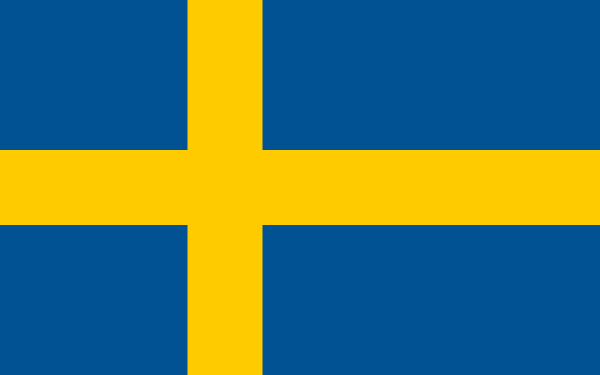
 Sweden is a Scandinavian country in Northern Europe that shares land borders with Norway and Finland. It is also connected to Denmark by a bridge tunnel across the Oresund.
Sweden is a Scandinavian country in Northern Europe that shares land borders with Norway and Finland. It is also connected to Denmark by a bridge tunnel across the Oresund.
The third largest country by area in the European Union with Stockholm as its capital Sweden has a population of around 9.5 million of whom the majority are situated in the south of the country. Whilst part of the European Union Sweden is not within the Euro currency zone and retains the Swedish Krona (SEK) as its national currency.
Numerous ferry operator run ferry services to and from Sweden. DFDS operate the only UK to Sweden services from Gothenburg to Immingham and Tilbury. Operators including Stena Line, Viking Line, Scandlines, Tallink Silja, TT Line, Unity Line, Polferries and Colorline provide a variety of routes connecting Sweden with Poland, Germany, Denmark, Norway, Lithuania, Latvia, Estonia and Finland. The Oresund bridge tunnel is a toll bridge and further details can be found at: ukoresundsbron.com
Payments can be simplifies on the Oresund crossing and many more toll roads/ bridges and tunnels by the use of the Easy Go scheme which recognises a number of toll tag providers.
Driver Requirements
Couriers, van operators, lorry and truck drivers are required to carry a full passport, appropriate national driving licence, driving hour’s records and a letter of authority to drive. Green card insurance is necessary and original documentation must be carried along with a certified copy of the operating company’s community authorisation which is supplied with standard international operating licences. Nationality plates must also be fixed to the back of the vehicle.
In Sweden they operate the ‘Eurovignette’ system whereby lorries and trucks over 12t that are used for the movement of freight pay a fee depending upon the amount of time the vehicle is in the country. Eurovignettes are also valid on E roads in Belgium, Luxembourg, the Netherlands and Denmark where the same payment system applies. In 2008 the paper style Eurovignettes were replaced by electronic means and are payable either via fuel card agents or by way of cash or credit cards at machines which are located in various petrol and service station areas. The most common and practical way to purchase however is on line at: eurovignette.eu/portal
The Eurovignette applies to the E4, E10, E12, E14, E22 and the E65 motorways in Sweden.
Vehicle Restrictions
All vehicles on Swedish roads have a width restriction of 2.6m and whilst height limits are unrestricted the road network is generally designed for up to 4.5m high. Weight restrictions apply depending on the number of axles and the space between axles. Generally the following gross weights are applicable. Two axles – 18t, three axles – 25t (26t if fitted with pneumatic suspension) and 31t (32t if pneumatic suspension is fitted) for four axle vehicles. In excess of these weights can be carried dependant on the distance between the outermost axles. EG – if the distance is 18m then 60t can be carried. Vehicles exceeding the above require special authorisation and application must be made to:
Vagverket (The Swedish Road Administration)
78187 Borlange
Sweden
Tel 00 46 243 750 00
Sweden is party to the ADR agreement in respect of the carriage of dangerous goods and such goods can be carried across the Oresund Bridge although travel times are restricted. Further details are available at: oeresund-bridge.com
Generally there are no travel restrictions at weekends or on public holidays other than on heavy vehicles on some summer weekends. Exemptions can be sought by contacting:
Gatu-och fastighetskontoret I Stockholm
Trafiknamndens Kansli
Box 8311
10420 Stockholm
Sweden
Tel 00 46 8 785 6000
Low emission zones based on the Euro rating of diesel powered vehicles have been introduced. Euro 2 and 3 rated vehicles have an eight year entry period from date of first registration with Euro 4 vehicles allowed to enter until 2016 and Euro 5 standard allowed to enter until 2020. The zones and further details can be found at:
lowemissionzones.eu or at 2.trafikkontoret.goteborg.se
Couriers, van operators, lorry and truck drivers should also be aware that seat belts ae compulsory, dipped headlights must be on at all times whilst driving, HGVs must be fitted with an audible reversing alarm, a spare set of bulbs must be carried and it is also recommended to carry a warning triangle, first aid kit, tow rope, jump leads reflective jacket and a fire extinguisher. Whilst not compulsory to carry snow chains between 1 December and 31 March all vehicle must have winter tyres marked M & S fitted (3.5mm on vehicle with an mpw of 3.5t and less 5mm on vehicle with a mpw of more than 3.5t. further information on the use of winter tyres is available at
transportstyrelsen.se/en/road/vehicles/winter-tyres/
It should also be noted that drink driving rules are stricter in Sweden than the rest of Europe and if the level of alcohol in the bloodstream exceeds 0.02 percent then severe penalties by way of fines, licence loss and even prison will be applied. Random breath tests are carried out and drivers must accept a test if requested. On the spot fines can be applied and are either payable at the time of the offence or at a bank within 2 – 3 weeks.
In case of emergency contact 112 for all the emergency service – police, fire brigade and ambulance service. If dialling from a phone box use the red SOS button or dial #9. Breakdown assistance can be called on 020 912 912.
Further information and assistance is available from
Swedish Haulage Association info@akeri.se or Tel: 00 46 8 753 5400
Swedish Transport Authority Tel: 00 46 8 405 1000



 United Kingdom
United Kingdom Republic of Ireland
Republic of Ireland Polska
Polska România
România Republica Moldova
Republica Moldova Российская Федерация
Российская Федерация Украина
Украина Республика Беларусь
Республика Беларусь Литва
Литва Латвия
Латвия Эстония
Эстония Deutschland
Deutschland Schweiz
Schweiz Österreich
Österreich Lichtenstein
Lichtenstein Belgien
Belgien Luxemburg
Luxemburg Magyarország
Magyarország Česká republika
Česká republika Slovenská republika.
Slovenská republika. España
España Italia
Italia Bulgaria
Bulgaria









